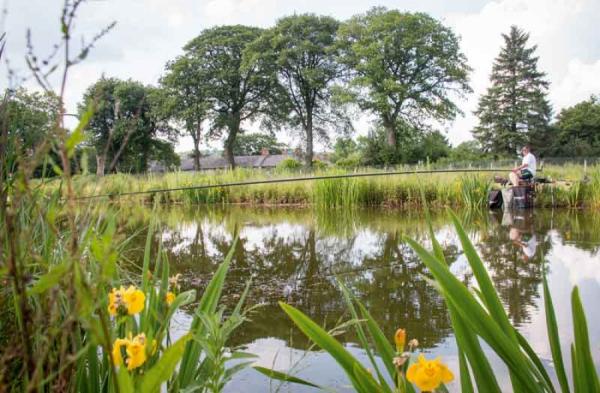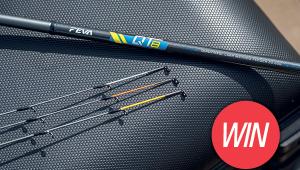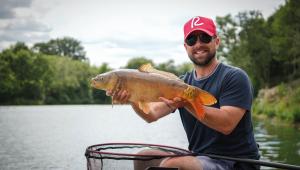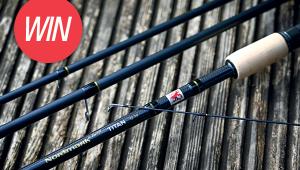Into The Lion’s Den!

Andy Oldham explains why snags needn’t be as scary as they first look!
It’s a situation that crops up on many of the more established commercial fisheries around the country… lakes full of fish, but the carp are only too happy to reside in any snags dotted around the lake. These more cautious fish have been caught time and again during match hours and know that the snags offer them a bit of safety.
Hooking fish in snags is rarely the problem. Fish tend to feed with confidence when they are holed up in the safety of the snags so bites are usually easy to come by. Getting the fish out is where the problems start to arise! A dense reed bed full of fish can very quickly become a tackle graveyard if it is not targeted correctly. Hopefully my pointers will give you a head start when you are next faced with a challenging snaggy swim.
Be Realistic
Although the tackle I use and the tactics I use are great, you do need to be realistic with where you are going to fish. For instance, there is often a semi-submerged bush in commercial fisheries that is full of carp; quite often you will be able to see them right in the back of said feature. Hooking one would not be an issue, but how can you expect to actually land a fish from such an area?
I guess my point is to assess the snag and fish where you know that you can safely land the fish. Fishing in stupid places will not only be bad for the fish, but it will be bad for your pole!
Today, for example, I am faced with a dense reed bed that comes away several metres from the far bank. It is easy to see where the bulk of the fish are, right at the back of the reed bed. I could fish there, but I am sure I would just lose 90 per cent of the fish I hook so it is simply not worth it. Instead, I am going to fish just in the front of the reeds. I am not frightened to go into them a bit, but don’t push your luck and just be sensible.
Shallow Is King
One thing you will find when fishing to snags or reeds is that the swim will often be fairly deep. It is not unusual to find three to four feet of water in front of the reeds, which poses its own problems.
If you think about it, when you get a bite on a rig of this length, the fish can already be well on its way into the reeds before it has even registered. That is a big problem and is often a cause for many of the fish losses that occur when fishing to snags.
For this reason, I believe fishing shallow is a must. When you hook a fish shallow, it is so instant and direct that you immediately have pulling power to get the fish away. The cover of the snags also means that the fish will feed confidently shallow much earlier in the day and quite often you don’t require that building-up period that you often need when fishing shallow in open-water swims.
Blasting bait into the reeds has become a fantastic tactic on many commercials and when the fish respond it can be absolutely deadly.
So if faced with a snaggy swim, be confident with your feed and use a rig at half depth or less. It can make landing fish a doddle from these areas.
Man Tackle!
There simply is no place for faffing around when fishing like this. Snags mean strong tackle and don’t let anybody tell you otherwise! Robust, durable tackle is a must.
Line choice is relatively simple. You may be wondering why I am not using a rig straight through and it is a good question. Put simply, if I do get snagged up and need to pull for a break I need a weak point somewhere in the rig, otherwise I may have problems getting my tackle back!
Today I am using 0.24mm Frenzee FXT Loaded Mono for my main line (a whopping 12.8lb breaking strain) with a 0.20mm hooklength of the same material. The main line is incredibly durable and I would be amazed if anything could break it on pole tackle! This is important as it is going to be rubbing against the snags throughout the session, so it needs to be hard wearing.
The next thing to consider is hook choice. A strong piece of steel is a must and the Loaded 1624 hooks fit the bill perfectly. A size 16 is my choice today but I will have no hesitation in upping the hook size should I see fit.
Interestingly, I always prefer an eyed hook. Today I am banding a pellet so you would expect that, but even if I were mounting the bait on to the hook directly an eyed hook would be my choice, simply for strength reasons.
Floats are again very strong and the Frenzee FO2 is ideal. These floats are simple, super-strong patterns with nice thick visible bristles. They work well for both fishing on the bottom and shallow and a 0.2g is my choice for the shallow rig, simply shotted with a bulk of No10s.

These tensioning beads from Frenzee allow you to tighten up your elastic in snaggy swims, but afterwards you can re-set them to how they were!
Elastic Enforcement
As I said previously, strong tackle is the only way and that applies to elastic. My choice for snags is the Orange Frenzee Stretch, which is rated 14 to 18. This is threaded through the power kit, out of the Eeze Glyde system and I then attach a puller bead, which is a vital component of my elastic setup. The Frenzee Puller Beads have a clever taper system inside and their soft plastic nature grips the elastic tightly. This means that should I need a stronger elastic, I can simply pull the elastic through the bead to make the elastic tighter. Then once my session is over I can quickly return the elastic to how it was at the start.
It means that one size of elastic becomes very versatile indeed.
Feed Them Up
As I alluded to previously, I feed aggressively and rarely have the catapult out of my hand. Today I am using 4mm pellets but on other venues that bait could be casters or meat. It’s all about using what the venue responds to – that part doesn’t concern me too much.
However, how the bait is fed is the crucial part. In my head I like to work out when the bait has fallen around 18 inches and then I will feed again. Feeding in reeds means that bait going into them is inevitable; all the more reason to feed more often, as even when feeding large amounts only half will go where you intend!
Today I am feeding 15 pellets every 20 seconds. The noise and commotion will create a feeding frenzy in the swim and make the fish easier to catch.

Pellets make a loud noise when they hit the water, and can often draw fish out of snags.
Pull… HARD!
This section is not about bullying fish, but it is about showing them who is boss from the moment the fish is hooked! I’ve got the right tackle on and I am confident that it won’t let me down, so it’s now time to use it to the full.

Once the fish are out of the cover, take your time and make sure they end up in the net!
Once the fish is hooked, I will ship two or three sections behind me as quickly as possible. This can often startle the fish and may get them away without any drama. Once the pole is thrown back, I will raise it and assess what the fish is doing and what my next move needs to be. I may need to apply some side strain to steer the fish from the snags, for instance.
A trick I like to employ is to actually raise the pole quite high. The key is to just get the fish in the keepnet, so don’t worry what you look like doing it. Raising the pole can often confuse the fish and often the fish will swim directly under the tip… perfect.

Fishing shallow into snags means you’re only using a short rig. This gives fish like this less chance to drag you into the cover!
Get Strong!
I must stress that while most poles are strong enough, I wouldn’t recommend trying this way of fishing with a normal match-style pole. Chances are they will be up to the job, but there is also every chance that they won’t be! A dedicated carp pole is a much safer bet and just keeps your mind at ease.
Today I am using the Frenzee Precision FXT Power pole; it is a great pole in its own right but as a backup pole it is simply superb. More than strong enough for even the most demanding of situations, it really is a great bit of kit.
The Session
I am fishing a short session on the match lake at Frenzee Hayfield Lakes today. The venue holds plenty of quality carp in but the lake is notoriously weedy and the peg I am on has a dense reed bed across.
I am fishing shallow in among the reeds and every time I hook a fish, all hell breaks loose! By being confident in my tackle, I only lose three of the 21 carp that I hook, which given the scenario is pretty good going in my book.
Tightening the elastic by 18 inches proved to be important and that is where the Puller Beads really score, as I can quickly adjust the elastic to suit the situation.
Snag fishing needn’t be off-putting but you do need to follow some key guidelines and really think about your fishing and what you are trying to achieve. The golden rules are be sensible, gear up and fish shallow!

A range of small factors all add up to the secret of snag fishing, but the biggest is your confidence!
Like what you see?
Or buy a single issue
- Log in or register to post comments









